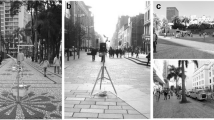Abstract
The physiological equivalent temperature, PET, is a thermal index derived from the human energy balance. It is well suited to the evaluation of the thermal component of different climates. As well as having a detailed physiological basis, PET is preferable to other thermal indexes like the predicted mean vote because of its unit (°C), which makes results more comprehensible to urban or regional planners, for example, who are not so familiar with modern human-biometeorological terminology. PET results can be presented graphically or as bioclimatic maps. Graphs mostly display the temporal behaviour of PET, whereas spatial distribution is specified in bioclimatic maps. In this article, some applications of PET are discussed. They relate to the evaluation of the urban heat island in cities in both temperate climates and warm climates at high altitude. The thermal component of the microclimate in the trunk space of a deciduous forest is also evaluated by PET. As an example of the spatial distribution of PET, a bioclimatic map for Greece in July (Mediterranean climate) is presented.
Similar content being viewed by others
Author information
Authors and Affiliations
Additional information
Received: 7 April 1999 / Accepted: 26 May 1999
Rights and permissions
About this article
Cite this article
Matzarakis, A., Mayer, H. & Iziomon, M. Applications of a universal thermal index: physiological equivalent temperature. Int J Biometeorol 43, 76–84 (1999). https://doi.org/10.1007/s004840050119
Issue Date:
DOI: https://doi.org/10.1007/s004840050119




